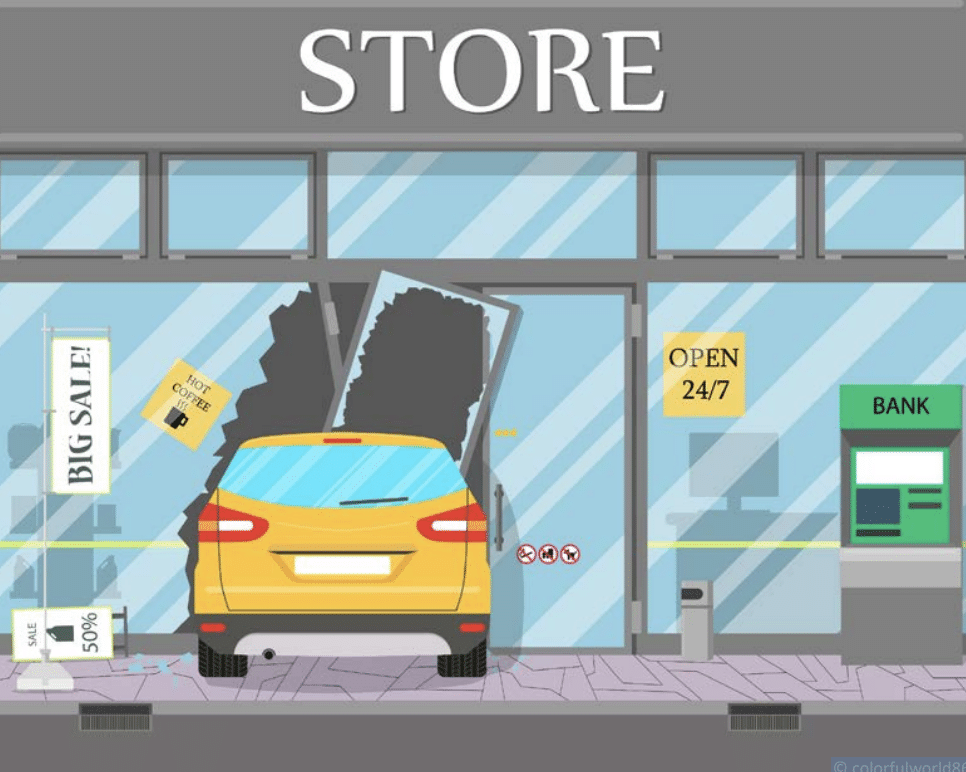On a pavement situated in a shopping center, a passerby was struck by a vehicle that had gone out of control while attempting to park in the mall’s parking area. The operator mistakenly stepped on the accelerator instead of the brake pedal, and no safeguards were in place, save for a meager curb that could have stopped the vehicle from leaping onto the pavement and colliding with the pedestrian who was walking between stores.
This is referred to as “pedal error” or “pedal misapplication.” In the United States, more than 20,000 such events happen each year, resulting in collisions with storefronts or harm to pedestrians. This phenomenon is well understood by commercial property owners and managers, chain store vendors, and government entities. To safeguard pedestrians in front of shops or in open-air dining locations, a few laws have been enacted, which necessitate commercial property owners to set up protective barriers such as bollards or wheel stops.
When such circumstances take place in California, does a commercial property owner have a legal obligation to the victim, bringing the property owner’s potential carelessness in failing to provide protective devices between the parking lot and the pavement into question?
Although this hypothetical scenario contains factual and legal issues that are subject to litigation uncertainty, there are at least two factual scenarios where, based on current case law, a judicial determination of a legal obligation is more probable than it would otherwise be.
These are circumstances in which: (1) cars in the parking lot are aimed squarely at the pedestrian victim, and (2) the property owner offered some type of advantage or enticement to the pedestrian victim to be in the location where the accident occurred.
Normally, the issue arises through a motion for summary judgment filed by the property owner of the shopping center, alleging a lack of legal obligation as a foundation for negating the plaintiff victim’s negligence claim.
Applicable Duty Principles
Under California law, individuals are obligated to exercise reasonable care for the safety of others. Property owners are non-delegable in their duty of care. Exceptions to the general duty of ordinary care should only be made by courts when foreseeable harm and policy considerations justify a categorical no-duty rule. In a motion to establish that there is no duty of care, a defendant must affirmatively negate the existence of duty.
In determining the factors for duty, the most important considerations are the foreseeability of harm to the plaintiff, the degree of certainty that the plaintiff suffered injury, the closeness of the connection between the defendant’s conduct and the injury suffered, the moral blame attached to the defendant’s conduct, the policy of preventing future harm, the extent of the burden to the defendant and consequences to the community of imposing a duty to exercise care with resulting liability for breach, and the availability, cost, and prevalence of insurance for the risk involved.
The primary dispute in this analysis is typically the foreseeability of harm. Foreseeability should not be based solely on probability but should consider what is likely enough in the setting of modern life that a reasonable person would take account of it in guiding practical conduct.
The degree of foreseeability required may be lesser in cases where there are strong policy reasons for preventing the harm or where the harm can be prevented by simple means. In this case, the plaintiff argues that preventing harm is crucial to reducing “runaway vehicle” incidents harming customers and can be achieved by installing inexpensive protective devices such as bollards and wheel stops.
Foreseeability analysis varies depending on the potential duty owed to whom. When a special relationship exists between the defendant and plaintiff, courts have found an affirmative duty to protect the plaintiff from the conduct of third parties. In this case, such a special relationship exists between the business proprietor and customers.
Robison v. Six Flags Theme Parks Inc. and Jefferson v. Qwik Korner Market, Inc.
In cases involving “runaway vehicles” or “pedal errors,” legal analysis often focuses on three reported decisions. The most recent authority on this matter is Robison v. Six Flags Theme Parks Inc. (1998) 64 Cal. App.4th 1294, where a car in the Magic Mountain parking lot failed to stop and hit plaintiffs seated at a picnic table. The court found the incident foreseeable because the parking lane was aimed directly at the picnic table with no barriers or safety features separating the two.
The lack of prior similar incidents was not a basis for summary judgment, and the court held that the landowner bears a duty to protect against the first occurrence of an unreasonable risk of danger.
Barker v. Wah Low (1971) 19 Cal. App.3d 710 is another relevant case where a patron at an outside service window was struck by a car moving forward over wooden “bumper stops.” The court concluded that the risk was foreseeable, and it would not have been an inordinate burden on the owners or operators to install more substantial barriers.
Barker v. Wah Low
Recent non-precedential cases, such as Call v. Walmart Stores, Inc. (2021) 2021 WL 512218 and Beaudreau v. Burham USA Equities, Inc. (2022) 2022 WL 3593351, suggest that there may be no legal duty in these situations without specific facts such as the vehicle being pointed directly at the plaintiff or an enticement to be at the location of the incident.
Conclusion
In conclusion, factual variants may alter the likelihood of prevailing against a motion for summary judgment by a commercial property owner in a “runaway vehicle” situation.
It is essential to consider prior incidents, the positioning of vehicles and protective barriers, and any enticement for pedestrians or customers to gather and linger at the location where the incident occurred.
You can read the original version of the article published on the CAOC Forum.


